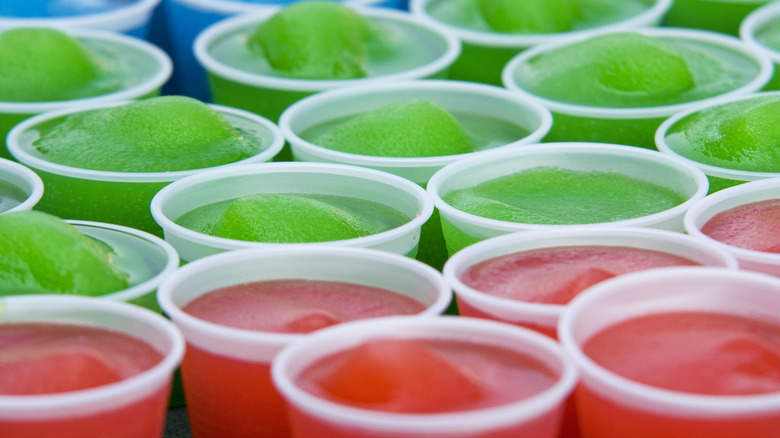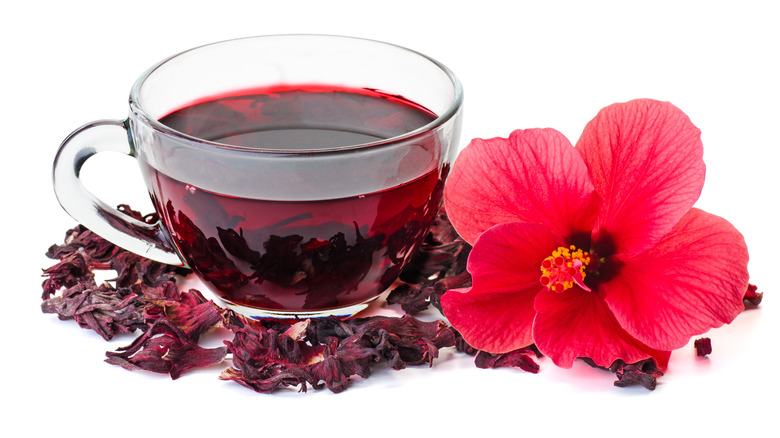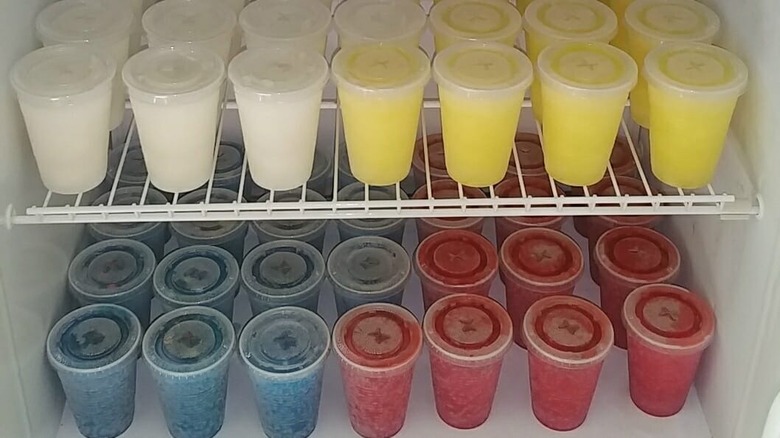The Classic Southern Frozen Cup Treat That Goes By Many Names
Some call it a "frozen cup," others a "huckabuck," "honeydripper," "freeze cup," "chilly bear," "lilly dilly," "flip," "thrill," or "cherry berry." This polyonymous treat can be found in neighborhoods around the United States, but particularly in the South, where it serves as a welcome refresher to beat the sweltering summer heat. It consists of a frozen red drink (typically Kool-Aid, but sometimes fruit punch, snoball syrup, or even Jello powder dissolved in water) served in a disposable cup, and it's sort of like a stickless popsicle or an Otter Pop. Sometimes, bits of candy or fruit might be frozen within the mixture. They don't come in flavors, they come in colors, so if you ever order one, be sure to ask for "red" instead of "cherry." It's an incredibly simple thing, but the best foods don't need to be complex — they just need to be delicious.
Frozen cups — as we'll call them here, since balancing the dessert's many names is a near-impossible task — have historically been sold on the local level, typically by an older woman in the neighborhood who, depending on your local lingo, would be known as the "huckabuck lady," "honeydripper lady," etc. The standard price for a cup ranges from 25 to 50 cents, making these goodies a natural hit with children, who only need a bit of pocket change for the ultimate summer vacation refreshment. Frozen cups are particularly popular within Black American communities, and their surprisingly complex history is intricately interwoven with the African diaspora.
Frozen cup desserts have roots in West Africa
The exact origin of the frozen cup treat is unclear, but it appears to represent a collision of two historical forces: red drinks and ice. What is a "red drink"? The term historically refers to a variety of sweet beverages typically flavored with berries or hibiscus, which have a bright red hue. They can be traced to West Africa, where people have been making red teas from hibiscus and cola nuts for at least 400 years. There are multiple versions, but Smithsonian Magazine says the best-known may be bissap, which originated in Senegal and originally served a medicinal purpose. When West Africans were enslaved and forced to the Americas, some brought hibiscus seeds with them, finding that the plant thrived in the Caribbean. There, bissap was reinvented with the addition of local ingredients and given a new name: sorrel.
In the United States, hibiscus doesn't grow as easily, so red berries replaced it in the traditional beverage. The term "red drink" first appeared in writing in the 1870s South, where it referred to a version of lemonade made by Black Americans with strawberries or sumac for color and enjoyed on special occasions, such as honoring emancipation. By the early 1900s, the industrial world had caught onto this market, producing bottled red beverages such as Big Red, Faygo, and of course, Kool-Aid. Today, red drink remains an iconic soul food staple and is particularly enjoyed on Juneteenth, keeping its ties to emancipation celebrations.
Red drink plus ice equals frozen cup
To understand how red drink may have given birth to the beloved frozen cup dessert that bears so many names across the nation, we need to talk about ice. Before the electric freezer was invented in the early-1900s, ice had to be harvested from natural sources, i.e. frozen lakes and ponds. Of course, this could only be done in the dead of winter, and the market for ice-cold drinks doesn't really come around until the summer, so ice had to be stored in ice houses, insulated structures with drainage systems to get rid of the portion that inevitably melted. The ability to drink an iced beverage was a status symbol in its own right, and many of the United States' Founding Fathers — including George Washington and Thomas Jefferson — had ice houses built on their plantations.
In the early 1800s, an enterprising merchant named Frederic Tudor made a fortune shipping ice from Massachusetts to the Southern states and Caribbean islands, where it was immensely popular in the hot summers. These ice-trading routes closely paralleled those of the slave trade, with the grueling labor of shipping and storing ice being forced upon enslaved peoples, while the refreshment itself was kept to wealthy whites. However, the successive events of emancipation in the 1860s and industrial ice manufacturing in the early 1900s shifted the availability, making ice, as well as frozen treats, available to Black Americans. At some point, someone stuck a cup of red drink in a freezer, and the frozen cup/huckabuck/honeydripper/chilly bear/lilly dilly was born.


